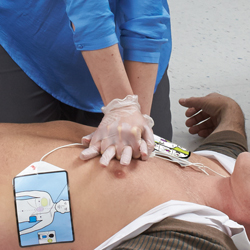Is it Safe to Perform CPR during COVID-19?

When sudden cardiac arrest (SCA) strikes, bystander intervention can make the difference between life and death. One of the most important links in the Chain of Survival is to provide cardiopulmonary resuscitation (CPR) as soon as possible. Without CPR, an SCA victim’s chance of survival significantly decreases minute by minute.
Because it can take 7-14 minutes for emergency services to arrive, bystanders should be prepared to help by administering CPR.1 But in the midst of the pandemic, is it safe to help a victim of out-of-hospital cardiac arrest (OHCA)?
The American Heart Association (AHA) and the European Resuscitation (ERC) have both published interim guidance on how to perform CPR during COVID-19. Because there is no way to know if a victim or a rescuer may be infectious, the guidelines now recommend using personal protective equipment (PPE) to help prevent viral spread while performing CPR. This includes covering both your own and the victim’s mouth and nose with a mask or cloth. Rescuers should also wear gloves if possible. The AHA and ERC also recommend using hands-only CPR and have eliminated the recommendation to provide rescue breaths.
In summary:
- Call 9-1-1
- Ask a bystander to retrieve the nearest automated external defibrillator (AED)
- Cover your own mouth and nose with a mask or cloth; do the same for the victim
- Perform hands-only CPR: Push hard and fast on the center of the victim’s chest
- Administer the AED as soon as it is available
Upon arrival, the emergency services team will take over care of the victim. However, your early intervention will have increased the likelihood of a positive outcome.
Some AEDs tell you when to begin performing CPR and provide feedback on the quality of your chest compressions, and many use auditory prompts to talk you through these steps, allowing you to keep your eyes on the victim so you can focus on providing high-quality CPR .
After helping in a rescue, remove your gloves one at a time. Peel one glove down over the other to contain any contaminants, and then safely discard them. Wash your hands thoroughly with soap and water for two minutes. If you do not have access to soap and water, use an alcohol-based hand sanitizer.
Download our poster on how to perform hands-only CPR during COVID-19 so everyone in your organization can safely help in a cardiac emergency.
11. Mell HK, et al.JAMA Surg. 2017;152:10:983-984. DOI:10.1001/jamasurg.2017.2230.
